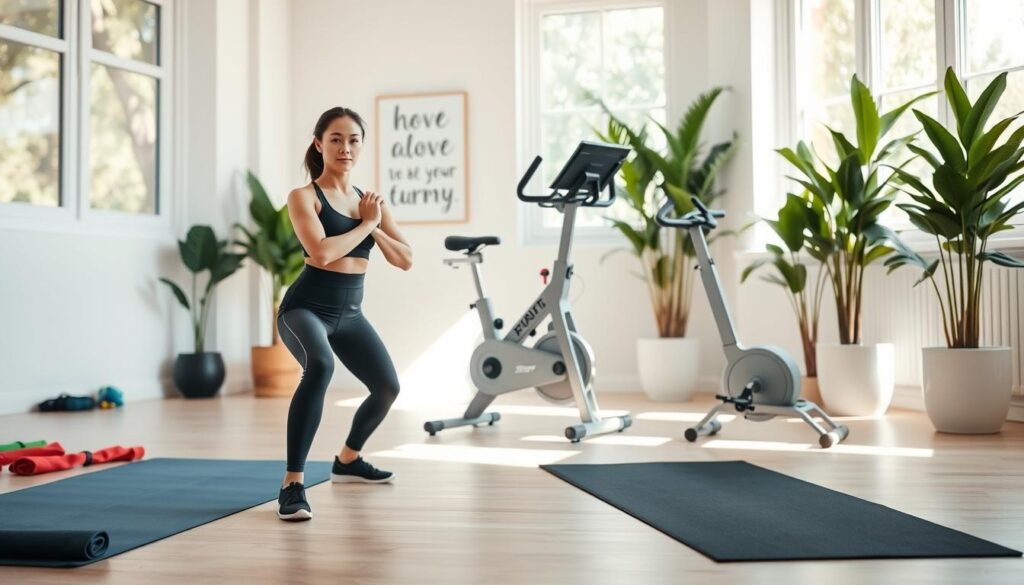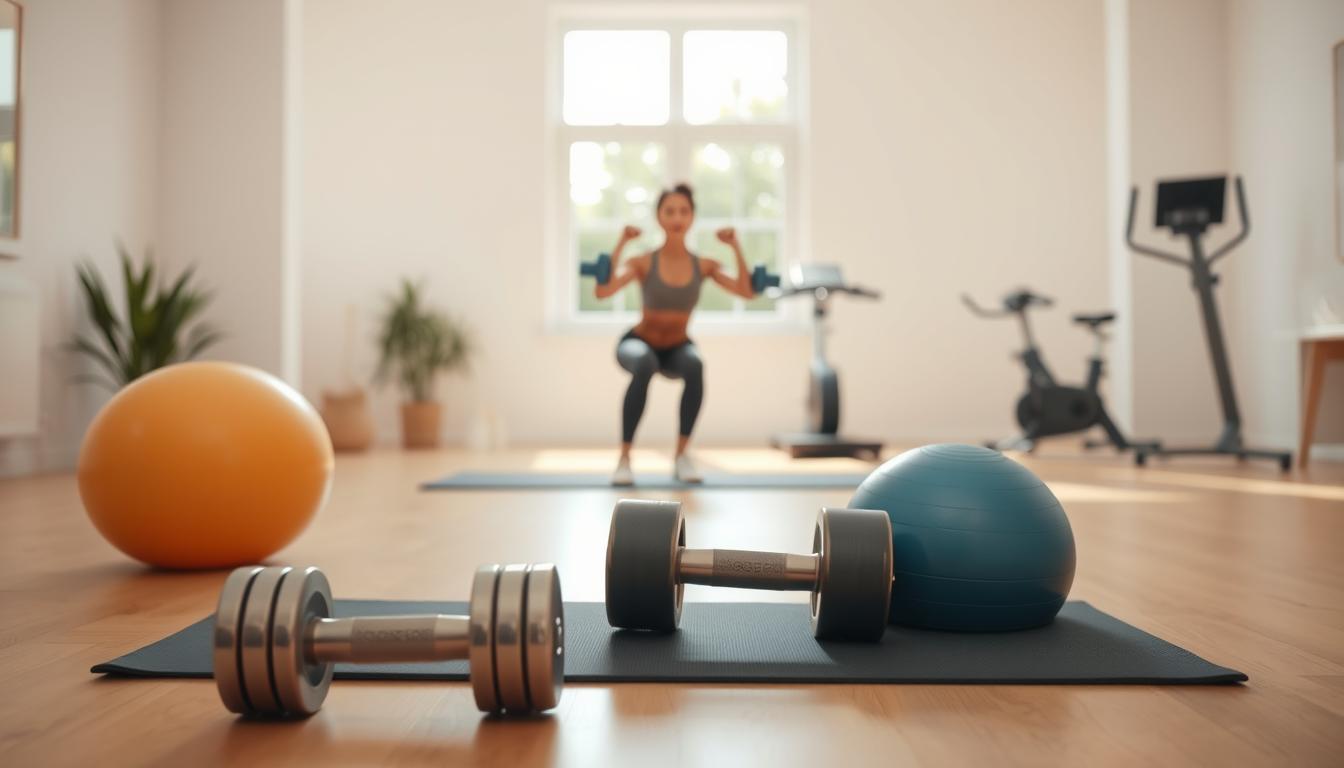Did you know that regular exercise can reduce the risk of chronic diseases by up to 30%? Starting a beginner friendly fitness plan can be a life-changing decision, and it’s easier than you think.
Embarking on a beginner workout routine can seem daunting, but with a clear plan, you can achieve everyday fitness and improve your overall well-being.
Key Takeaways
- Start with a manageable workout plan
- Focus on consistency rather than intensity
- Gradually increase exercise duration and frequency
- Combine cardio and strength training for overall fitness
- Make exercise a habit by scheduling it
Why Starting a Fitness Journey Matters
Embarking on a fitness journey is a significant step towards a healthier, more balanced life. As individuals begin this journey, they often wonder what benefits they can expect and how to set achievable goals.
Health Benefits for Beginners
Starting a beginner exercise routine can lead to numerous health benefits, including improved cardiovascular health, increased strength, and enhanced flexibility. Regular physical activity can also boost mental health by reducing stress and anxiety. As beginners progress, they can expect to see improvements in their overall well-being and energy levels.
An easy workout plan for starters typically includes a mix of cardio, strength training, and flexibility exercises. This balanced approach helps beginners build a solid foundation for their fitness journey.
Setting Realistic Fitness Goals
Setting realistic fitness goals is crucial for success. Beginners should start with achievable targets, such as following a basic daily workout schedule, and gradually increase the intensity and duration as they progress. It’s essential to be patient and celebrate small victories along the way.

By understanding the benefits and setting realistic goals, individuals can stay motivated and committed to their fitness journey. This approach helps ensure a positive and sustainable experience for beginners.
Preparing Your Body and Mind for Fitness
Before diving into a daily fitness routine, it’s crucial to prepare both your body and mind. This preparation phase is essential for a successful and sustainable fitness journey. It involves acquiring the right equipment, setting up a conducive workout environment, and mentally preparing yourself for the challenges ahead.
Essential Equipment for Beginners
As a beginner, you don’t need to invest in expensive gym equipment. Simple, versatile tools like resistance bands, a yoga mat, and dumbbells can be very effective. Resistance bands are lightweight and portable, making them ideal for home workouts or when traveling. A good quality yoga mat provides the necessary grip and cushioning for various exercises. Dumbbells are versatile weights that can be used for strength training exercises.
Creating a Workout Space at Home
Having a dedicated workout space at home can significantly enhance your motivation and consistency. Choose a quiet, well-ventilated area with enough space to move around. Ensure the floor is clear of clutter and consider using a non-slip mat or flooring. Good lighting and a mirror can also enhance the workout experience, allowing you to check your form and posture.
Mental Preparation Techniques
Mental preparation is just as important as physical readiness. Techniques such as meditation and deep breathing exercises can help reduce stress and improve focus. Setting realistic goals and tracking progress can also boost motivation. It’s essential to cultivate a positive mindset, focusing on the journey rather than the destination.
By preparing your body and mind, you set yourself up for success in your fitness journey, making it more likely to stick to your quick and simple beginner’s workout routine.
A Simple Daily Fitness Routine for Beginners
Establishing a daily fitness routine is a crucial step for beginners to achieve their fitness goals. A well-structured routine helps in creating a habit and ensures that progress is made consistently. In this section, we will outline a simple daily fitness routine that includes a warm-up sequence, strength training circuit, cardio segment, and cool-down stretching.
5-Minute Morning Warm-Up Sequence
Starting with a warm-up sequence is essential to prepare the muscles for more intense exercise. This 5-minute routine will get your blood flowing and reduce the risk of injury.
Dynamic Stretching Exercises
Dynamic stretching involves moving your joints through a range of motion while keeping your muscles active. Examples include leg swings, arm circles, and torso twists. These exercises help in improving flexibility and preparing your muscles for the workout ahead.
Light Cardio Activation
Light cardio activation, such as jogging in place or jumping jacks, helps in increasing your heart rate and blood flow. This prepares your cardiovascular system for more intense exercise and enhances overall performance.
15-Minute Strength Training Circuit
Strength training is a crucial component of any fitness routine. It helps in building muscle, increasing metabolism, and enhancing overall strength. Here are some basic exercises that beginners can follow:
Upper Body Exercises
- Push-ups: Works the chest, shoulders, and triceps.
- Dumbbell rows: Targets the back and biceps.
Lower Body Exercises
- Squats: Works the quadriceps, hamstrings, and glutes.
- Lunges: Targets the legs and improves balance.
Core Strengthening Moves
- Plank: Strengthens the core and improves posture.
- Russian twists: Targets the obliques.
10-Minute Cardio for Beginners
Cardio exercises are essential for improving heart health and burning calories. Here are some beginner-friendly options:
Walking and Jogging Intervals
Alternating between walking and jogging is a great way to start cardio training. It allows you to gradually increase your intensity and endurance.
Low-Impact Alternatives
For those who prefer lower impact exercises, options like cycling or swimming are excellent alternatives. They provide a good cardio workout without the high impact on joints.
5-Minute Cool-Down and Stretching
Cooling down after a workout is just as important as warming up. It helps in gradually bringing your heart rate back to normal and stretching the muscles to prevent soreness.
Some effective cool-down stretches include hamstring stretches, quad stretches, and chest stretches. Holding each stretch for 15-30 seconds and breathing deeply will help in maximizing the benefits.
Progressing Your Workout: 7-Day Plan
To get the most out of your beginner workout routine for everyday fitness, consider implementing a 7-day plan that gradually increases in intensity. This plan will help you build a strong foundation, improve your overall fitness, and achieve your goals.
Days 1-2: Building Foundation
Start by establishing a baseline fitness level with a gentle routine. For the first two days, focus on short, manageable workouts that include a mix of cardio, strength training, and flexibility exercises. For example, you can start with a 10-minute brisk walk, followed by some light stretching and bodyweight exercises like push-ups and squats.
- Warm-up: 5-minute walk or jog
- Strength training: bodyweight exercises (push-ups, squats, lunges)
- Cardio: 10-minute brisk walk or jog
- Cool-down: stretching exercises
Days 3-5: Increasing Intensity
As you progress, it’s essential to gradually increase the intensity of your workouts. For days 3-5, add more challenging exercises, such as resistance band training or more complex bodyweight exercises. You can also increase the duration of your cardio sessions.
- Warm-up: 5-minute dynamic stretching
- Strength training: resistance band exercises or more complex bodyweight exercises
- Cardio: 15-20 minute steady-state cardio (jogging, cycling, or swimming)
- Cool-down: static stretching exercises
Days 6-7: Active Recovery and Rest
After increasing the intensity, it’s crucial to allow your body to recover and rebuild. For days 6-7, focus on active recovery techniques, such as yoga or light swimming, and make sure to get plenty of rest.
- Active recovery: yoga, light swimming, or cycling
- Rest: take a day off from intense workouts
- Stretching: focus on static stretches to improve flexibility
Nutrition and Hydration to Support Your Fitness Routine
Supporting your fitness journey requires not just a consistent workout routine but also a focus on nutrition and hydration. A well-balanced diet and adequate hydration are crucial for maximizing the benefits of your simple daily fitness routine for beginners. Proper nutrition helps fuel your workouts, supports recovery, and enhances overall performance.
Pre and Post-Workout Nutrition
Eating the right foods before and after your workouts can significantly impact your performance and recovery. For beginners, it’s essential to understand that pre-workout nutrition should focus on complex carbohydrates and lean proteins to provide energy and support muscle function. Post-workout, consuming a mix of protein and carbohydrates can help in muscle recovery and replenishing energy stores.
- Pre-Workout: Oatmeal with fruits, whole-grain toast with peanut butter, or a banana with yogurt.
- Post-Workout: Protein shake with banana, chicken salad with quinoa, or Greek yogurt with berries.
Hydration Guidelines for Beginners
Staying hydrated is vital for physical performance and overall health. Beginners should aim to drink at least 8-10 glasses of water per day, adjusting according to the intensity and duration of their workouts. It’s also important to drink water before, during, and after exercise to prevent dehydration.
- Drink water as soon as you wake up.
- Have a glass of water before and after your workout.
- Monitor your urine color; it should be light yellow.
Simple Meal Planning Tips
Meal planning can simplify healthy eating and support your fitness goals. For an easy workout plan for starters, focus on balanced meals that include a variety of foods from all food groups. Here are some tips:
- Plan your meals for the week ahead.
- Shop for fresh, whole foods.
- Prepare meals in advance to save time.
By combining a simple daily fitness routine for beginners with proper nutrition and hydration, you can enhance your overall fitness journey and achieve your goals more effectively.
Conclusion
Starting a daily fitness routine is just the first step; maintaining it is where the real journey begins. By following the beginner friendly fitness plan outlined in this guide, you’re well on your way to achieving your fitness goals. Remember, consistency is key to seeing progress and enjoying the benefits of regular exercise.
As you continue on your fitness journey, it’s essential to stay motivated and committed to your beginner exercise routine. Celebrate your small victories, and don’t be too hard on yourself when you encounter setbacks. With time and persistence, you’ll develop a healthy habit that will improve your overall well-being.
By incorporating a balanced diet and proper hydration, as discussed in the nutrition section, you’ll be able to support your fitness goals and enhance your overall performance. Stay committed, and you’ll be on your way to a healthier, more active lifestyle.
